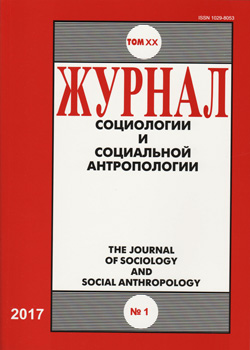Social Conditions for the Use of Technology and Cognitive Processes
Abstract
The article shows the relevance of the analysis of the broader context of productive human activities in modern anthropology of technology. The different views of this context were made salient in anthropology of technology starting from evolutionary view, in works of a French scientist A. Leroi-Gourhan, to cognitive view, which has become a subject of research in modern times. The identification of the broad context of technology application is a reflection of the continuum approach to the analysis of technology that encompasses biological and social sciences. The distinction between the concepts of technological fact and technological trend make it possible to determine what elements of technology are culturally and socially determined. It is important to highlight the concept of the technological environment and its relationship with the social environment. In anthropology of technology the general trend of evolution is associated with the phenomenon of externalization; it can be considered as the basis for the genesis of technological activity. Technological activities are organized in the operating chain. The concept of operating chain allows us to consider social relations and culture as aspects of technological activity. The study of cognitive processes allows us to understand the connection between technology as a set of techniques and artifacts and socio-cultural context. A number of researchers have shown that the integration of the social component of the technology is done at the individual cognitive level. The social component of the technology is probably fixed in the automatic cognitive processes of categorization and stereotyping. The deficit of cognitive resources in the environment oversaturated by artifacts and agents of social relations is a frequent situation, even in everyday life. This increases the likelihood that the perceiving subject will use the previously activated stereotypes.References
Токарев С.А. (1973) А. Леруа-Гуран и его труды по этнографии и археологии. Этнологические исследования за рубежом. М.: Наука.
Allport G.W. (1954) The nature of prejudice. Reading, MA: Addison-Wesley.
Audouze F. (2002) Leroi-Gourhan, a Philosopher of Technique and Evolution. Journal of Archaeological Research, 10(4): 227–306.
Bargh J.A. (1989) Conditional automaticity: Varieties of automatic influence in social perception and cognition. In: J.S. Uleman, J.A. Bargh (Eds.). Unintended thought. New York: Guilford: 3–51.
Ferguson E.S. (1992) Designing the World We Live. In: Research in Engineering Design Theory, Applications, and Concurrent Engineering. Springer-Verlag New York Inc.
Francolini C.M., Egeth H. (1980) On the nonautomaticity of ‘‘automatic’’ activation: Evidence of selective seeing. Perception and Psychophysics, 27: 331–342.
Gilbert D.T., Hixon J.G. (1991) The trouble of thinking: Activation and application of stereotypic beliefs. Journal of Personality and Social Psychology, 60(4): 509–517.
Ingold T. (1990) Society, Nature, and the Concept of Technology. Archaeological Review from Cambridge, 9(1): 5–17.
Johnson M.K., Hasher L. (1987) Human learning and memory. Annual Review of Psychology, 38: 631–668.
Leeuw S. van der. (1993) Giving the potter a choice. In: Technological Choices, P. Lemonnier (ed.). London: Routledge: 238–288.
Lemonnier P. (1992) Elements for an Anthropology of Technology, Anthropological Papers. University of Michigan Museum.
Leroi-Gourhan A. (1943) Evolution et techniques L’Homme et la matière. Т. I. Paris: Albin Michel.
Leroi-Gourhan A. (1945) Evolution et techniques Milieu et techniques. Т. II. Paris: Albin Michel.
Leroi-Gourhan A. (1993) Gesture and speech. The MIT Press.
Logan G.D. (1989) Automaticity and cognitive control. In: J.S. Uleman, J.A. Bargh (eds.). Unintended thought. New York: Guilford: 52–74.
Read D., Leeuw S. van der. (2008) Biology is only part of the story... Philosophical Transactions of the Royal Society B: Biological Sciences, 363(1499), 1959–1968. DOI: 10.1098/rstb.2008.0002.
Renfrew C. (2008) Neuroscience, evolution and the sapient paradox: the factuality of value and of the sacred. Philosophical Transactions of the Royal Society B: Biological Sciences. Jun 12; 363(1499): 2041–49. DOI: 10.1098/rstb.2008.0009.
Allport G.W. (1954) The nature of prejudice. Reading, MA: Addison-Wesley.
Audouze F. (2002) Leroi-Gourhan, a Philosopher of Technique and Evolution. Journal of Archaeological Research, 10(4): 227–306.
Bargh J.A. (1989) Conditional automaticity: Varieties of automatic influence in social perception and cognition. In: J.S. Uleman, J.A. Bargh (Eds.). Unintended thought. New York: Guilford: 3–51.
Ferguson E.S. (1992) Designing the World We Live. In: Research in Engineering Design Theory, Applications, and Concurrent Engineering. Springer-Verlag New York Inc.
Francolini C.M., Egeth H. (1980) On the nonautomaticity of «automatic» activation: Evidence of selective seeing. Perception and Psychophysics, 27: 331–342.
Gilbert D.T., Hixon J.G. (1991) The trouble of thinking: Activation and application of stereotypic beliefs. Journal of Personality and Social Psychology, 60(4): 509–517.
Ingold T. (1990) Society, Nature, and the Concept of Technology. Archaeological Review from Cambridge, 9(1): 5–17.
Leeuw S. van der. (1993) Giving the potter a choice. In: Technological Choices, P. Lemonnier (ed.). London: Routledge: 238–288.
Lemonnier P. (1992) Elements for an Anthropology of Technology, Anthropological Papers. University of Michigan Museum.
Leroi-Gourhan A. (1943) Evolution et techniques. L’Homme et la matière. V. I. Paris: Albin Michel.
Leroi-Gourhan A. (1945) Evolution et techniques. Milieu et techniques. V. II. Paris: Albin Michel.
Leroi-Gourhan A. (1993) Gesture and speech. The MIT Press.
Logan G.D. (1989) Automaticity and cognitive control. In: J.S. Uleman, J.A. Bargh (eds.) Unintended thought. New York: Guilford: 52–74.
Read D., Leeuw S. van der. (2008). Biology is only part of the story... Philosophical Transactions of the Royal Society B: Biological Sciences, 363(1499), 1959–1968. DOI: 10.1098/rstb.2008.0002
Renfrew C. (2008) Neuroscience, evolution and the sapient paradox: the factuality of value and of the sacred. Philosophical Transactions of the Royal Society B: Biological Sciences. Jun 12; 363(1499): 2041–49. doi: 10.1098/rstb.2008.0009.
Tokarev S.A. (1973) A. Leroi-Gourhan i yego trudy po etnografii i arkheologii. In: Etnologicheskiye issledovaniya za rubezhom [A. Leroi-Gourhan and his works on ethnography and archeology. Ethnological studies abroad]. Moscow: Nauka (in Russian).

